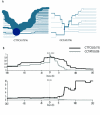The ADH1B Arg47His polymorphism in east Asian populations and expansion of rice domestication in history
- PMID: 20089146
- PMCID: PMC2823730
- DOI: 10.1186/1471-2148-10-15
The ADH1B Arg47His polymorphism in east Asian populations and expansion of rice domestication in history
Abstract
Background: The emergence of agriculture about 10,000 years ago marks a dramatic change in human evolutionary history. The diet shift in agriculture societies might have a great impact on the genetic makeup of Neolithic human populations. The regionally restricted enrichment of the class I alcohol dehydrogenase sequence polymorphism (ADH1BArg47His) in southern China and the adjacent areas suggests Darwinian positive selection on this genetic locus during Neolithic time though the driving force is yet to be disclosed.
Results: We studied a total of 38 populations (2,275 individuals) including Han Chinese, Tibetan and other ethnic populations across China. The geographic distribution of the ADH1B*47His allele in these populations indicates a clear east-to-west cline, and it is dominant in south-eastern populations but rare in Tibetan populations. The molecular dating suggests that the emergence of the ADH1B*47His allele occurred about 10,000 to approximately 7,000 years ago.
Conclusion: We present genetic evidence of selection on the ADH1BArg47His polymorphism caused by the emergence and expansion of rice domestication in East Asia. The geographic distribution of the ADH1B*47His allele in East Asia is consistent with the unearthed culture relic sites of rice domestication in China. The estimated origin time of ADH1B*47His allele in those populations coincides with the time of origin and expansion of Neolithic agriculture in southern China.
Figures



Similar articles
-
Ethnic related selection for an ADH Class I variant within East Asia.PLoS One. 2008 Apr 2;3(4):e1881. doi: 10.1371/journal.pone.0001881. PLoS One. 2008. PMID: 18382665 Free PMC article.
-
Geographically separate increases in the frequency of the derived ADH1B*47His allele in eastern and western Asia.Am J Hum Genet. 2007 Oct;81(4):842-6. doi: 10.1086/521201. Epub 2007 Aug 24. Am J Hum Genet. 2007. PMID: 17847010 Free PMC article.
-
Diversification of the ADH1B gene during expansion of modern humans.Ann Hum Genet. 2011 Jul;75(4):497-507. doi: 10.1111/j.1469-1809.2011.00651.x. Epub 2011 May 18. Ann Hum Genet. 2011. PMID: 21592108 Free PMC article.
-
Ancient DNA elucidates the migration and evolutionary history of northern and southern populations in East Asia.Yi Chuan. 2025 Jan;47(1):18-33. doi: 10.16288/j.yczz.24-224. Yi Chuan. 2025. PMID: 39791296 Review.
-
Origin of ethnic groups, linguistic families, and civilizations in China viewed from the Y chromosome.Mol Genet Genomics. 2021 Jul;296(4):783-797. doi: 10.1007/s00438-021-01794-x. Epub 2021 May 26. Mol Genet Genomics. 2021. PMID: 34037863 Review.
Cited by
-
Ferment in the family tree.Proc Natl Acad Sci U S A. 2015 Jan 13;112(2):308-9. doi: 10.1073/pnas.1421566112. Epub 2014 Dec 31. Proc Natl Acad Sci U S A. 2015. PMID: 25552552 Free PMC article. No abstract available.
-
Population genetic studies in the genomic sequencing era.Dongwuxue Yanjiu. 2015 Jul 18;36(4):223-32. doi: 10.13918/j.issn.2095-8137.2015.4.223. Dongwuxue Yanjiu. 2015. PMID: 26228473 Free PMC article. Review.
-
Relationship between rice farming and polygenic scores potentially linked to agriculture in China.R Soc Open Sci. 2021 Aug 18;8(8):210382. doi: 10.1098/rsos.210382. eCollection 2021 Aug. R Soc Open Sci. 2021. PMID: 34457340 Free PMC article.
-
Human population dynamics and Yersinia pestis in ancient northeast Asia.Sci Adv. 2021 Jan 6;7(2):eabc4587. doi: 10.1126/sciadv.abc4587. Print 2021 Jan. Sci Adv. 2021. PMID: 33523963 Free PMC article.
-
Population genomics advances in frontier ethnic minorities in China.Sci China Life Sci. 2025 Apr;68(4):961-973. doi: 10.1007/s11427-024-2659-2. Epub 2024 Dec 4. Sci China Life Sci. 2025. PMID: 39643831 Review.
References
-
- Tishkoff SA, Reed FA, Ranciaro A, Voight BF, Babbitt CC, Silverman JS, Powell K, Mortensen HM, Hirbo JB, Osman M, Ibrahim M, Omar SA, Lema G, Nyambo TB, Ghori J, Bumpstead S, Pritchard JK, Wray GA, Deloukas P. Convergent adaptation of human lactase persistence in Africa and Europe. Nat Genet. 2007;39(1):31–40. doi: 10.1038/ng1946. - DOI - PMC - PubMed
-
- Gong ZT, Chen HZ, Yuan DG, Zhao YG, Wu YJ, Zhang GL. The temporal and spatial distribution of ancient rice in China and its implications. Chinese Sci Bull. 2007;52(8):1071–1079. doi: 10.1007/s11434-007-0130-3. - DOI
Publication types
MeSH terms
Substances
LinkOut - more resources
Full Text Sources

